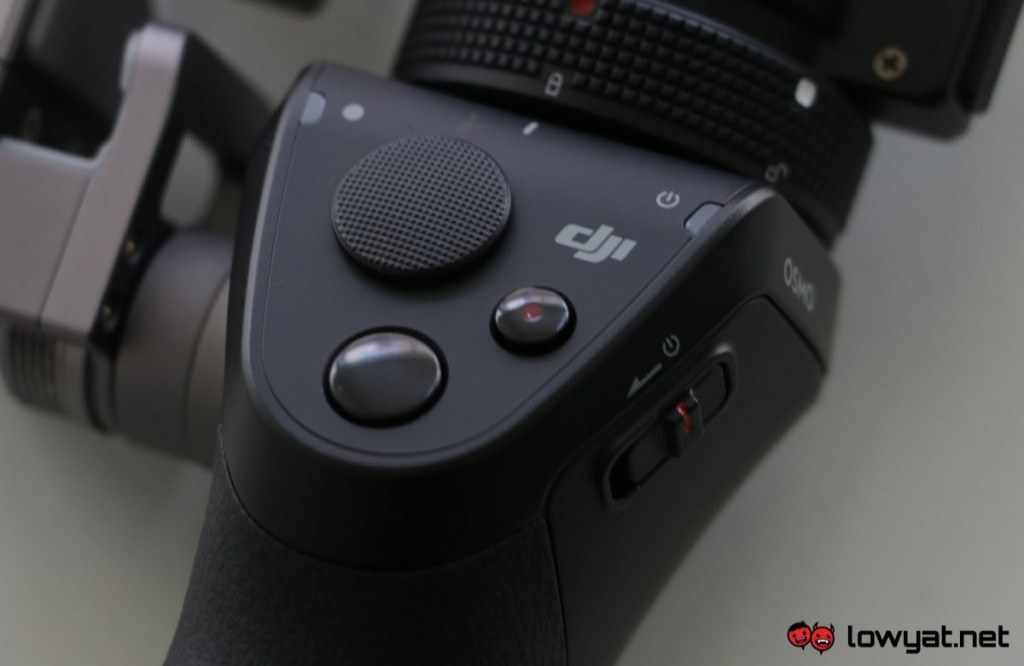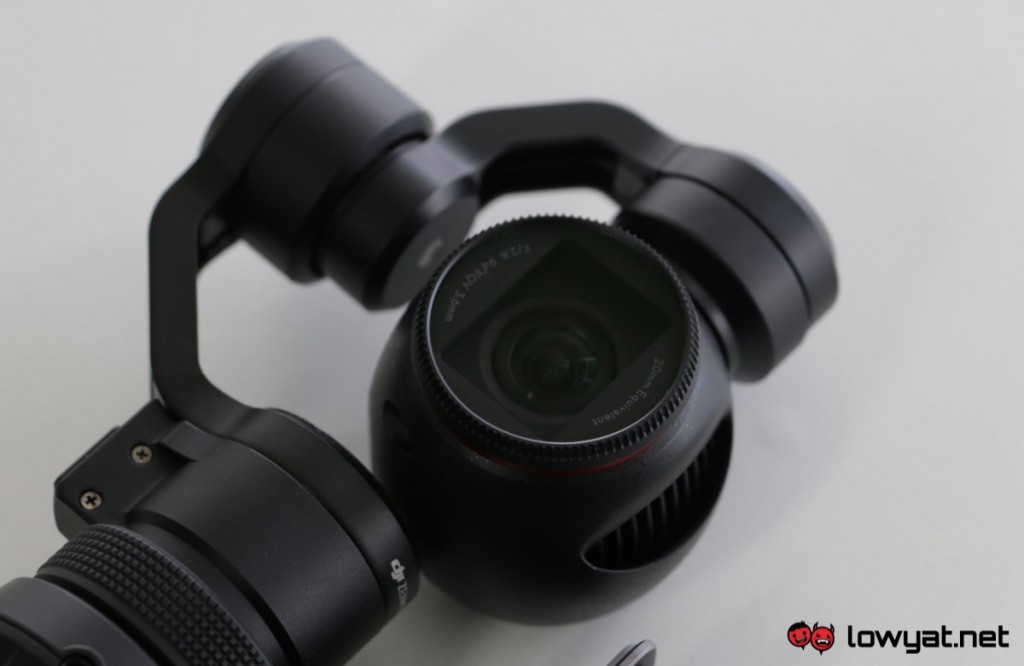Apart from making big badass drones for aerial videography, DJI also dabbles with mobile videography with the Osmo. First unveiled back at CES 2015, the DJI Osmo is essentially a handheld 4K video camera taken from the DJI Inspire 1, mounted on a dedicated gimbal.
There aren’t many dedicated video cameras with gimbal systems in the market right now; most of them are actually OEM systems that are modeled after the Osmo. But with a price tag of RM2,399, it may be a tough sell for most of us.
Design
The DJI Osmo comes in four parts – a Zenmuse X3 camera and gimbal system, a grip, a 900mAh battery and a collapsible phone holder. Put them together and you have a 4K video camera with a dedicated gimbal system that weighs a total of 538 grams. On its own, it’s pretty comfortable to use, but it becomes significantly more tiring when you’ve got a phone mounted with the Osmo.
That said, the added heft actually helps with stabilising the whole rig.

All buttons on the Osmo are very well placed. Each button is easily accessible with the thumb and they provide decent tactile feedback. The power button is placed on the right, with the center surface having the directional pad, image capture button, as well as the record button.
Having said that, I’m a right hander, and all the buttons are designed for right handers. Left handers will feel the design to be a bit uncomfortable, not just with the button placement, but even more so with the phone holder on the left.
Apart from that, the overall build quality on the DJI Osmo is rather solid. From the neck down, the Osmo feels really firm and durable, but the neck up, not so much. Let me explain.
When the Osmo is powered off, the camera portion of the device feels really flimsy even when it’s locked back into position. It’s probably due to the fact that the Zenmuse X3 camera is essentially floating in mid-air – I doubt that the gimbal would break easily, but it just feels fragile enough that I’d take extra care when handling the Osmo.
Software
I wanted to replicate how an average consumer would use the DJI Osmo, so I didn’t toy around much with the software. The good thing is, everything is pretty much already set up for you right out the box.
You can use the Osmo with or without a smartphone, but if you need a viewfinder, you’ll need to pair the Osmo with a smartphone via the DJI Go app. There’s a microSD card slot in there, so you can shoot in 4K without ever pairing it with a smartphone. That said, it’s always better to have a live preview via the app.
The DJI Go app has a UI that’s easy on the eyes and rather easy to navigate. Not only does the app act as a viewfinder for your smartphone, it also lets you tweak the Osmo’s settings. You can change video resolution, select colour output, re-calibrate the Osmo, perform firmware updates, and most importantly, check how much battery is left.
While the app is packed with tonnes of features, there are some flaws with it. If there are any issues with the WiFi Direct connection while recording, the live preview on the smartphone will appear choppy. Thinking there may be issues with the actual footage, I’d stop recording and review the footage – only to find the video perfectly fine.
Besides that, the Osmo won’t automatically re-pair with your smartphone when you restart it. You’d have to check your phone’s Wi-Fi settings again to make sure it’s connected, then re-launch the app.
Performance
Right out the box, the DJI Osmo records smooth and professional looking 4K video with very little effort. The three-axis stabilisation works very well considering its size, and it really is a lot of fun seeing the footage knowing how little effort is done to record it.
Not only that, it can also take RAW and JPG still images. There is a dedicated camera shutter button next to the video recording button, which is useful when you need it. However, colours in both video and photo can get pretty saturated and slightly oversharpened at times.
Besides that, the DJI Osmo also has some neat features, like pressing the trigger button twice on the front to recentre the camera, or pressing it thrice to switch to selfie mode. Pairing the Osmo with the companion app just makes it easier to use, adding to the overall Osmo experience.
The coolest feature, of course, is the stabilisation lock feature. You can “lock” a frame simply by holding the trigger button while recording; virtually all movement you make will be countered by the gimbal, resulting in satisfyingly smooth footage. There is some minimal bobbing when walking, as you will see in the demo footage we shot.
That being said, battery life is a major concern for the Osmo. The 900mAh battery on the Osmo only gave me roughly an hour’s use on a full charge, and I wished it could’ve lasted longer. That said, you may get better battery life when shooting in lower resolutions, but make no mistake: this battery is tiny, and you should get a spare battery for the Osmo.
On top of that, the internal microphone isn’t sensitive enough, which is very likely because of all that noise coming from the X3 camera’s fans. You’ll need an external microphone attachment for the Osmo if you want better audio, or else you’ll end up with sub-par audio accompanying professional looking video.
The Zenmuse X3 camera also has a fixed focal length, lacking macro capabilities with the minimum focus distance set at 1.5m. There’s also no preset or user-programmed camera motions for users to plan their shots.
Videos taken with the Osmo can sometimes get grainy, and it gets worse when you try to record in a poorly-lit indoor environment. The video camera also produces a lot of noise (the audible kind) as it records in 4K, because the internal fan ramps up the speed to keep the Osmo cool.
Have a look at some of the 4K footage we shot with the DJI Osmo:
Outdoor (Day)
Outdoor (Night)
Stabilisation Test
Conclusion
Nevertheless, the DJI Osmo is an amazing 4K video camera with great stabilisation features. The Osmo’s design makes it easy to hold, to handle, and you can actually switch the video camera module (with the better quality Zenmuse X5).
I brought the Osmo along for our recent assignment at Computex 2016 to give it some real-life challenges, and there were a few key observations. While there is no doubt about video quality and stabilisation prowess, battery life stuck out like a sore thumb. I can’t be carrying this for eight to nine hours for just one (or two with a spare battery) hour’s worth of footage.
That said, the DJI Osmo is a very interesting alternative for videographers, both for amateurs and enthusiasts. RM2,399 is actually affordable, considering how much 4K-capable DSLR and mirrorless cameras are going for. Just remember to spare some additional cash for additional batteries.










I found your blog quite interesting and the concern in the blog is really impressive
ReplyDeleteDji Osmo Gimbal Camera
Good This is truly a great read for me. I have bookmarked it and I am looking forward to reading new articles. Keep up the good work!. infrared camera for drones
ReplyDelete